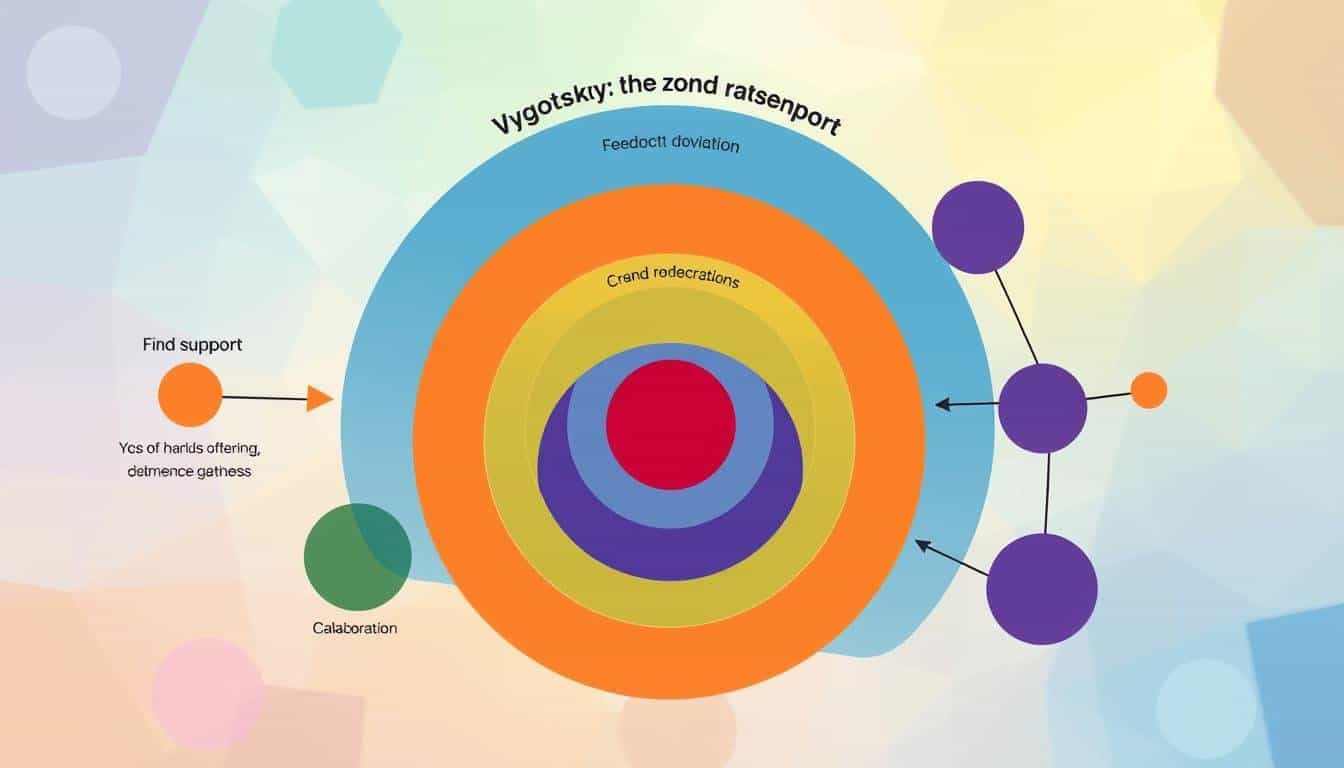Understanding Vygotsky’s Zone of Proximal Development
Have you ever thought about why some students do well with help, while others find it hard, even if they’re just as smart? This question is central to Vygotsky’s Zone of Proximal Development (ZPD). It changes how we see learning and how our minds grow. Lev Vygotsky, a famous psychologist, came up with this idea. He said the ZPD is the gap between what students can do on their own and what they can do with help from someone who knows more.
This idea helps teachers improve how they teach. It also creates a better place for students to work together and get involved. We’ll look into what makes Vygotsky’s ZPD important for learning and how it changes how we think about teaching.
Key Takeaways
- The ZPD represents the range of tasks a learner can accomplish with assistance.
- Social interaction is key to advancing problem-solving abilities.
- Scaffolding provides targeted support to learners within their ZPD.
- Collaborative learning enhances understanding and independent skills.
- Vygotsky emphasized that a student’s problem-solving abilities are better indicators of intelligence than traditional test scores.
- Understanding ZPD helps educators tailor learning experiences to individual needs.
Introduction to Vygotsky’s Theory
Vygotsky’s theory shows how important social interactions are in learning. He believed that people grow by talking and working with others who know more, like teachers or friends. This idea highlights how working together helps us learn and grow.
The Zone of Proximal Development (ZPD) is a key idea in Vygotsky’s theory. It’s the gap between what we can do on our own and what we can do with help. When we try tasks in this zone, we learn more because of the support we get. Vygotsky used this idea to question old ways of testing learning, showing how guidance helps us reach our full potential.
Vygotsky’s theory shows that how we think and learn is shaped by our culture and the people around us. He believed that talking and sharing experiences with others helps us learn and grow. This idea shows how working together can make learning better.
Language is very important in Vygotsky’s theory. He said that language goes through different stages, from talking with others to thinking silently. These stages help us share our thoughts and understand better. Vygotsky thought that the world around us plays a big part in how we think and develop.
| Concept | Description |
|---|---|
| Zone of Proximal Development | Distance between current and potential cognitive capabilities with support |
| More Knowledgeable Other (MKO) | Person who aids in the learner’s development via guidance |
| Scaffolding | Supportive strategies to help learners complete tasks just beyond their ability |
| Language Development Stages | Social speech, private speech, inner speech as part of cognitive processes |
| Social Mediation | Influence of social interactions on psychological development |
The Zone of Proximal Development (Vygotsky)
The Zone of Proximal Development (Vygotsky) is key to understanding how learners can do better with help. It shows the gap between what learners can do alone and with help from teachers or friends. This idea is important for growing thinking skills through learning with others.
Definition and Importance
The Zone of Proximal Development (Vygotsky) is about what learners can do well with help. Tasks too hard or too easy are outside this zone. Knowing each learner’s ZPD is crucial for better learning results. Vygotsky’s theory says learning comes from working with others, making learning more effective.
Foundational Concepts of ZPD
Key ideas make up the Vygotsky ZPD Theory. Scaffolding is a big one, where experts use models, pictures, or talks to help learning. Friends can also help in the ZPD, making learning together more useful. The ZPD changes as learners grow, keeping learning exciting. Teachers use research and resources to create lessons that fit each student’s needs.
Key Features of the Zone of Proximal Development
The Zone of Proximal Development (ZPD) is a key part of Vygotsky’s learning theory. It shows how important social interaction and personalized support are for learning. It helps us see how ZPD makes learning more personal and encourages working together in school.
Dynamic and Changing Nature
The ZPD is always moving and changing as a person learns new things. It changes based on what a person knows and learns. Teachers who understand this can change their teaching to help each student grow best.
Individualized Learning Experiences
Every student has a unique ZPD based on their past knowledge, experiences, and the help they get. Making learning fit each student’s needs is crucial. This way, teachers can make lessons more engaging and help students learn better.
Collaboration and Support
Working together is key to using the ZPD well. When students work with others who know more, like friends or teachers, they can learn more deeply. This teamwork builds a supportive community in school, helping everyone do better in their studies.
Scaffolding in Education
Scaffolding in Education is a key method that helps students learn better. It uses various techniques to support students as they learn new things. Teachers give guidance, resources, and chances to work together. This helps students get good at new skills.
Definition of Scaffolding
Scaffolding is like a temporary support that helps students do tasks they can’t do alone. It gives them the right amount of help as they learn more. This way, students learn to take more responsibility for their learning.
It’s based on Vygotsky’s ideas. Scaffolding helps students grow by working with others and sharing ideas.
Examples of Scaffolding Techniques
Here are some ways to use scaffolding in schools:
- Modeling: Teachers show students how to do something, so they can watch and then try it themselves.
- Think-Alouds: Teachers talk about how they solve problems, showing students how to think it through.
- Peer Support: Students work together, with those who know more helping others understand hard topics.
- Guided Practice: Students practice new skills with teachers watching, building confidence before doing it alone.
- Feedback and Assessment: Regular checks help teachers see what each student needs, making learning plans just for them.
Using these scaffolding methods, teachers can make learning fun and supportive. Vygotsky’s ideas show how important working together is. This helps students get better at new skills and stay interested in learning.
Social Interaction in Learning
Social interaction is key in learning, as Vygotsky’s Sociocultural Theory shows. By working together, students share knowledge and grow their thinking skills. Vygotsky believed that learning is a social activity. Kids learn by talking with people who know more than they do.
Talking with friends and teachers helps kids learn more. These talks boost their thinking skills, like solving complex problems. Vygotsky said that learning from others, like teachers or peers, helps kids develop their thinking.
Learning with others is more than just talking. Adults help kids grow by doing activities together. They share their views and teach important thinking skills. Using methods like scaffolding and reciprocal teaching helps guide students in their learning.
Language is very important in learning. Vygotsky said that thinking out loud helps with problem-solving. Through working together, kids learn from each other. They improve their thinking and solving problems by sharing their experiences.
Here’s a table that shows how social interaction helps in learning, based on Vygotsky’s ideas:
| Aspect | Description |
|---|---|
| More Knowledgeable Other (MKO) | A teacher, parent, or peer who helps with learning by guiding them. |
| Zone of Proximal Development (ZPD) | The gap between what a child can do alone and what they can do with help. |
| Scaffolding | Help given to students, then slowly taken away as they get better. |
| Social Interaction | Very important for learning, through meaningful conversations. |
| Internalization | When kids take on cultural tools and ways of solving problems from their talks. |
Internalization of Knowledge in Vygotsky’s ZPD
Vygotsky’s Zone of Proximal Development (ZPD) highlights the key role of internalizing knowledge. This means taking what others share and making it your own. It helps learners move from learning with others to learning on their own. With guidance from someone more knowledgeable, they learn to think for themselves, using their own thoughts more.
Transition from Social to Individual Learning
At first, learners work together with others or teachers in the ZPD. They solve problems as a team. But as they get better, they learn to do things on their own. This change is made possible by internalizing knowledge. They start to handle tasks that were hard before, improving their thinking and doing skills step by step.
Active Engagement in Learning
Being active in learning helps students understand and own the material better. They use questions, group talks, and pictures to dive deep into their studies. This way, they get more from their learning, remembering and using what they learn in new situations.
In short, learning well in the ZPD combines social interaction and growing your own thinking. By internalizing knowledge and being active in learning, students gain a deep understanding. This lets them take on harder challenges with confidence.
Intersubjectivity: Shared Understanding in the Learning Process
Intersubjectivity in Learning is key to a team effort in school. It’s about teachers and students understanding each other. This understanding makes learning more fun and helps teachers teach better.
It’s also vital for scaffolding. This means teachers can adjust their help as students need it. This helps students learn more effectively.
Studies show that early childhood education is crucial. Intersubjectivity helps kids grow in many ways, not just in thinking. Teachers who really get this can help students learn best in their own learning zones.
Here’s some data that shows how important intersubjectivity is:
| State | Total Child Care Centers | NAEYC Accredited Centers | Percentage of Accredited Centers |
|---|---|---|---|
| Illinois | 4,001 | 411 | 10.2% |
| Wisconsin | 2,570 | 117 | 4.5% |
| Indiana | 1,640 | 237 | 14.4% |
Research over fifty years shows that social interactions boost learning. Vygotsky believed that learning happens with others, not alone. Knowing about intersubjectivity can make teaching better and help kids reach their full potential.
Contingency and Responsiveness in Teaching
Teaching is always changing, and teachers need to know what their students need. They must adjust their teaching to fit the students’ needs in real time. This means paying close attention to how students react to lessons.
Recognizing Learner Cues
Teachers must understand both what students say and what they don’t say. They look for signs that show students are confused, getting it, or need help. If a student seems unsure, like when they hesitate or look puzzled, the teacher should step in to help.
On the other hand, if a student seems sure and ready, the teacher can let them explore on their own. This helps students become more independent and in control of their learning.
Adjusting Support Appropriately
Teachers need to change how much help they give students as needed. This makes sure students are learning at their best level. They should be challenged but not so much that they get too stressed.
Using activities like Think, Pair, Share can help students work together and move forward on their own. This makes learning fun and engaging for everyone.
Challenges in Implementing the Zone of Proximal Development
Vygotsky’s Zone of Proximal Development (ZPD) helps us understand how we learn. But, making this theory work in real classrooms is hard. One big challenge is figuring out what each student can learn next.
Students in a classroom come from different backgrounds and have different skills. Finding out what each one needs to learn is hard. This can lead to problems in teaching them effectively.
Understanding Students’ Unique ZPD
Teachers must watch and assess students to see where they are in their learning. This is key to knowing what each student can do next. But, in big classes, this takes a lot of time and effort.
Some teachers don’t use ZPD correctly, which can cause confusion. So, it’s important to train teachers well in ZPD to help each student learn better.
Balancing Individual Needs in a Classroom
Teachers also face the challenge of meeting the different needs of all students. Some students need more help than others. This can make it hard to give everyone the support they need.
To fix this, teachers need good training and enough resources. This helps create a classroom where everyone can learn well together.







